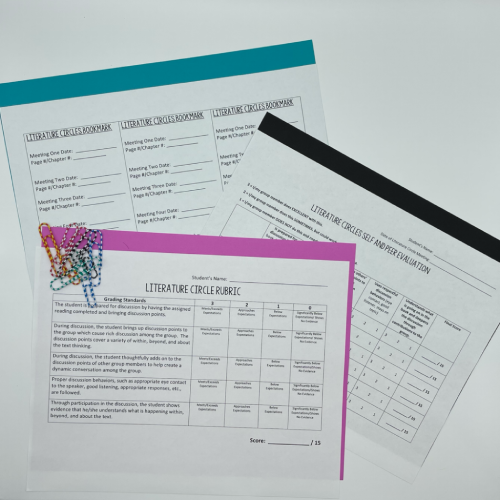The most common question I get asked on my blog, when I’m doing consulting work, and when I’m coaching is: I’m a middle school ELA teacher and have ____ amount of time each day. How do I fit it all in? This is a completely legitimate question. As middle school teachers, I often feel we are like the middle child: forgotten. Our reality is unlike that of an elementary teacher who has one group of students for the entire day and two or more hours to teach the literacy block. We are in the world of multiple groups of students, short time periods, and high expectations. Simply put, middle school is a different beast. Just because something is difficult or no clear-cut though, doesn’t mean it’s not possible. With some tweaks, tips, and tricks, I’m confident that you’ll be able to accomplish your curriculum goals while providing your students with literacy best practices.
1. Know Your Curriculum Goals
What is it that your students will learn and accomplish as readers and writers this year? For example, I am teaching 7th grade this year, and I would like my 7th grade students to accomplish the following:
-Read at least 40 books between independent reading, guided reading, literature circles, and interactive read alouds.
-Write and publish a narrative, persuasive, informational, and literary analysis piece of writing.
-Write a free choice piece of writing in any genre that is published once per month.
-Become more aware of word usage and grammar usage in any form of writing.
-Write in a variety of genres in response to their reading and be able to identify and analyze literary elements of a text.
-Speak comfortably in front of classmates to clearly communicate an idea.
-Participate in group discussions by actively listening to other classmates and extending ideas to generate intelligent, valuable conversation.
-To be able to summarize, connect, predict, infer, critique, and analyze their reading.
-Give meaningful feedback to peers when critiquing writing and during conversations about reading.
-To apply what is learned in class to the reading and writing they are exposed to in life and transfer the skills to real life situations they are faced with.
Now that I have articulated the WHAT, I will be able to more meaningfully determine the how. Based on goals for my students, the instructional contexts that I think will be the best vehicles to help me get there are: Interactive Read Aloud, Sentence Stalking, Word Study, Writing Workshop, Guided Writing, Writing Conferences, Reading Workshop, Guided Reading, Literature Circles, and Reading Conferences. Inputting these instructional contexts across the course of the school year to reach the above goals will help my students get to the destination. Working hard without a vision means you’re just working hard. You’re a hamster running on the wheel with no destination. Articulate your goals for your students and let the vision you’ve set drive the instruction that you provide.
2. Have a Schedule
Now that you have your goals and know what instructional strategies you will have to use in order to attain those goals, it’s time to make a schedule. For many of you with MAJOR time constraints, it’s time to get creative. Think day one/day two, alternating days, etc. Below are some mock schedules that I came up with based on varying amounts of time. To download this in a PDF document for free, click here.
3. Set Routines and Expectations
You can have the most beautifully written goals and the perfect schedule laid out to achieve those goals, but if you don’t take the time at the beginning of the year to set routines and expectations, you have nothing. I sometimes hear, “I can’t do guided reading/literature circles/guided writing/reading conferences/writing conferences because the other students just slack off when I’m working with small groups or one-on-one.” The answer is clear, no you can’t do small group and individual conferencing with students in your class until the routines and expectations of what independent reading or independent writing looks like a crystal clear without a smudge. If you have the attitude of, “They’re in middle school, they should just know and do all that stuff,” and end up skipping over building routines and expectations, the workshop model will most likely do a painful year-ending belly flop. Students like clear structure, predictability, and order within a classroom. Setting these things up will allow you to provide choice, independence, extension, and intervention for your students. My Reading Workshop Kick-off and Writing Workshop Kick-off products will help you lay the needed foundation for both of these workshop models to run the way they’re supposed to in your classroom.
4. Use a Timer
I’m going to let you in on a little secret that you’re not going to like. More often than not, the reason you don’t have enough time to get done with students what you intend to get done with students is because you’re talking too much. Whether we’ll admit it or not, most teachers who enter the profession love to talk about their subject area to students, and we can go on, and on, and on some more. You remember that schedule we talked about in Tip #2? There are time frames for each part of the schedule in there for a reason. USE THEM! Especially at the beginning of the year when you’re setting up the routines and expectations, use a timer to help you stay on track and make sure that you’re allowing students TIME to independently read and independently write while you are meeting with small groups and individuals. What you say during the minilesson is extremely important, but the TIME you allow students to explore that minilesson independently as readers and writers while you are instructing small groups of students and individuals at the level they need is when the true learning is going to occur. I guarantee most of us would grossly underestimate the time we spend in front of students talking. Hold yourself accountable and stick to the schedule you committed to. If you don’t have a timer, now is the time, click below and order it now. No excuses!
5. Put the Balance in Balanced Literacy
We all have our niche. For me, I LOVE writing and could spend endless time immersed in the writing process with my students. Balanced Literacy is reading, writing, listening, speaking, words, grammar, discussion, etc. Does your niche out balance all the other pieces that you’d like your students to accomplish in your class this year? Be reflective, and not to sound like a broken record here, but stick to the schedule you have set.
Don’t give up on being able to do it all at the middle school level and settle for sub-par instruction. Use trial and error until you find a schedule that allows you to meet the goals you have set for your students. They will be better readers and writers for it!










